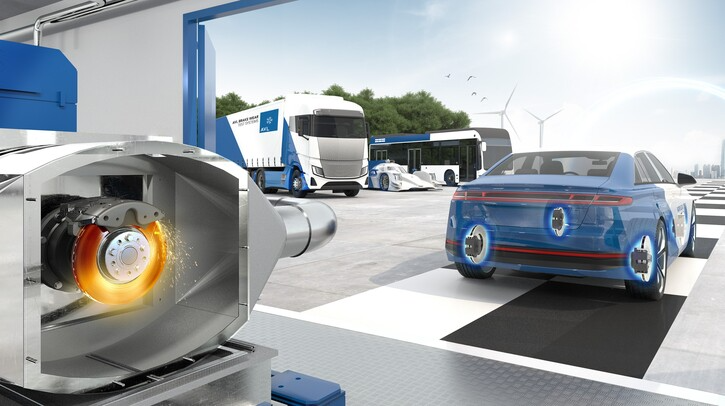*Sponsored content
Brake dust on shiny rims is annoying, but that is only the visible part of the story. Far more critical is the invisible fine dust created with every friction brake, threatening air quality and health. Now, the new Euro 7 emissions standard sets strict limits for these particles. What sounds like a challenge is also an opportunity: AVL combines engineering, simulation and testing expertise to help manufacturers not only comply, but also create cleaner, safer and more innovative brake systems
The first standard to regulate brake emission
Euro 7 marks a turning point. For the first time, non-exhaust emissions of brake and tire wear are part of the legislation. Alongside several changes, thresholds for particulate matter (PM10 and PM2.5) now also apply to braking systems. This makes the braking system both safety-critical and environmentally relevant. All vehicle types, including electric vehicles, must demonstrate compliance starting in late 2026.

A wake-up call for the industry
Independent interlaboratory studies (ILS) commissioned by the EU, as well as AVL’s own measurement campaigns underline the scale of the challenge: more than 60% of tested series-production brakes exceeded the upcoming Euro 7 limits. Depending on the system, measured PM10 values ranged from 6 to 20mg/km – compared to a threshold of 7mg/km for light-duty vehicles and just 3mg/km for EVs. These findings highlight the urgent need for innovation in brake system design, materials and validation methods.
Rethinking brake development
For manufacturers and suppliers, this means balancing traditional performance targets such as stopping distance, pedal feel, NVH and durability with ambitious emission reduction goals. AVL supports this transformation with solutions ranging from low-emission materials and advanced coatings to tribology concepts and filter technologies. Modern system approaches like brake-by-wire, electromechanical brakes and optimized recuperation strategies create additional opportunities to reduce wear particles – without compromising safety or comfort.
Virtual front loading for early insights
To master the complexity of brake emissions within tight timelines, simulation becomes essential. AVL Cruise M enables the creation of virtual twins where emission maps, braking strategies and vehicle controls interact under real drive cycles. Brake temperature, recuperation and battery state of charge can all be considered. Complementary computational fluid dynamics (CFD) models provide insights into particle behavior in the wheelhouse – including dispersion, deposition and resuspension. This combination enables emission-relevant effects to be understood and addressed early in development, long before physical prototypes are built. Simulation also enhances physical tests by revealing details that measurements alone cannot capture.
Validation: The decisive benchmark in brake emission testing
In the race to meet ever-tightening emission regulations, validation remains the critical step. AVL has established a global network of advanced brake emission testbeds, capable of measuring particulate mass and particle number down to 10 nanometers. These facilities leverage cutting-edge APC technology and gravimetric sampling methods, supported by a CFD-optimized sampling system that ensures consistent particle concentration and minimizes losses.
At the heart of this capability is the AVL APC xBrake, delivering high-resolution solid particle number (SPN) and total particle number (TPN) measurements with industry-leading sensitivity. This precision enables clear differentiation between emission sources, helping manufacturers comply with even the most stringent standards. Designed with serviceability in mind, the APC xBrake is backed by a global network of calibration and repair centers – minimizing downtime and maximizing productivity.
For automated particulate mass testing, AVL offers the PM Sampler xChange, which supports up to 16 consecutive tests without manual intervention. This enables high utilization in unmanned, automatic operations – ideal for continuous validation workflows.
Customers can choose between conducting tests at AVL’s state-of-the-art Test Factory or integrating AVL’s turnkey systems directly into their own facilities, ensuring flexibility and scalability in brake emission testing.
A seamless toolbox
The decisive factor is integration. AVL combines material and system development, simulation and testing into a single consistent workflow. Manufacturers can identify emission sources, countermeasures, optimize designs and ultimately validate systems – all with a single partner. This seamless approach shortens development cycles, reduces costs and provides confidence in Euro 7 readiness. Also, heavy-duty brake testing environments demand robustness. AVL Test Systems is built to last, even under high loads utmost measurement – accuracy and repeatability remain always in focus.
Beyond compliance
Euro 7 is a strong driver, but the benefits go beyond regulation. Cleaner brakes improve urban air quality, protect public health and support broader sustainability goals. At the same time, brake emission engineering fosters innovation in materials, system architectures and digital methods. With its comprehensive portfolio, AVL not only ensures compliance but also empowers customers to take the lead in shaping cleaner, safer and smarter mobility.
Explore emission limits and testing strategies, and futureproof brake solutions in this whitepaper


